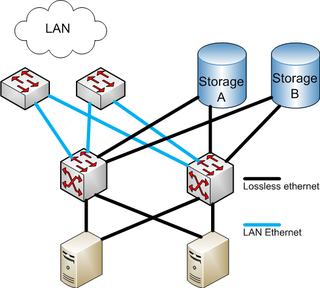
Small Computer System Interface is a set of standards for physically connecting and transferring data between computers and peripheral devices. The SCSI standards define commands, protocols, electrical, optical and logical interfaces. The SCSI standard defines command sets for specific peripheral device types; the presence of "unknown" as one of these types means that in theory it can be used as an interface to almost any device, but the standard is highly pragmatic and addressed toward commercial requirements. The initial Parallel SCSI was most commonly used for hard disk drives and tape drives, but it can connect a wide range of other devices, including scanners and CD drives, although not all controllers can handle all devices.

InfiniBand (IB) is a computer networking communications standard used in high-performance computing that features very high throughput and very low latency. It is used for data interconnect both among and within computers. InfiniBand is also used as either a direct or switched interconnect between servers and storage systems, as well as an interconnect between storage systems. It is designed to be scalable and uses a switched fabric network topology. By 2014, it was the most commonly used interconnect in the TOP500 list of supercomputers, until about 2016.
Fibre Channel (FC) is a high-speed data transfer protocol providing in-order, lossless delivery of raw block data. Fibre Channel is primarily used to connect computer data storage to servers in storage area networks (SAN) in commercial data centers.

SATA is a computer bus interface that connects host bus adapters to mass storage devices such as hard disk drives, optical drives, and solid-state drives. Serial ATA succeeded the earlier Parallel ATA (PATA) standard to become the predominant interface for storage devices.

Small Form-factor Pluggable (SFP) is a compact, hot-pluggable network interface module format used for both telecommunication and data communications applications. An SFP interface on networking hardware is a modular slot for a media-specific transceiver, such as for a fiber-optic cable or a copper cable. The advantage of using SFPs compared to fixed interfaces is that individual ports can be equipped with different types of transceiver as required.

The Storage Networking Industry Association (SNIA) is a registered 501(c)(6) non-profit trade association incorporated in December 1997. SNIA has more than 185 unique members, 2,000 active contributing members and over 50,000 IT end users and storage professionals. The SNIA absorbed the Small Form Factor Committee.
Switched fabric or switching fabric is a network topology in which network nodes interconnect via one or more network switches. Because a switched fabric network spreads network traffic across multiple physical links, it yields higher total throughput than broadcast networks, such as the early 10BASE5 version of Ethernet and most wireless networks such as Wi-Fi.
The InterNational Committee for Information Technology Standards (INCITS),, is an ANSI-accredited standards development organization composed of Information technology developers. It was formerly known as the X3 and NCITS.
Brocade is an American technology company specializing in storage networking products, now a subsidiary of Broadcom Inc. The company is known for its Fibre Channel storage networking products and technology. Prior to the acquisition, the company expanded into adjacent markets including a wide range of IP/Ethernet hardware and software products. Offerings included routers and network switches for data center, campus and carrier environments, IP storage network fabrics; Network Functions Virtualization (NFV) and software-defined networking (SDN) markets such as a commercial edition of the OpenDaylight Project controller; and network management software that spans physical and virtual devices.
Advanced Telecommunications Computing Architecture is the largest specification effort in the history of the PCI Industrial Computer Manufacturers Group (PICMG), with more than 100 companies participating. Known as AdvancedTCA, the official specification designation PICMG 3.x was ratified by the PICMG organization in December 2002. AdvancedTCA is targeted primarily to requirements for "carrier grade" communications equipment, but has recently expanded its reach into more ruggedized applications geared toward the military/aerospace industries as well. This series of specifications incorporates the latest trends in high speed interconnect technologies, next-generation processors, and improved Reliability, Availability and Serviceability (RAS).
In computing, the FC-HBA API is an Application Programming Interface for Host Bus Adapters connecting computers to hard disks via a Fibre Channel network. It was developed by the Storage Networking Industry Association and published by the T11.5 committee of INCITS An "early implementers version" was published in 2000, and the current version was completed in 2002.
Fibre Channel Protocol (FCP) is the SCSI interface protocol utilising an underlying Fibre Channel connection. The Fibre Channel standards define a high-speed data transfer mechanism that can be used to connect workstations, mainframes, supercomputers, storage devices and displays. FCP addresses the need for very fast transfers of large volumes of information and could relieve system manufacturers from the burden of supporting a variety of channels and networks, as it provides one standard for networking, storage and data transfer. Some Fibre Channel characteristics are:

Fibre Channel over Ethernet (FCoE) is a computer network technology that encapsulates Fibre Channel frames over Ethernet networks. This allows Fibre Channel to use 10 Gigabit Ethernet networks while preserving the Fibre Channel protocol. The specification was part of the International Committee for Information Technology Standards T11 FC-BB-5 standard published in 2009.

A storage area network (SAN) or storage network is a computer network which provides access to consolidated, block-level data storage. SANs are primarily used to access data storage devices, such as disk arrays and tape libraries from servers so that the devices appear to the operating system as direct-attached storage. A SAN typically is a dedicated network of storage devices not accessible through the local area network (LAN).

In computing, Linux-IO (LIO) Target is an open-source implementation of the SCSI target that has become the standard one included in the Linux kernel. Internally, LIO does not initiate sessions, but instead provides one or more Logical Unit Numbers (LUNs), waits for SCSI commands from a SCSI initiator, and performs required input/output data transfers. LIO supports common storage fabrics, including FCoE, Fibre Channel, IEEE 1394, iSCSI, iSCSI Extensions for RDMA (iSER), SCSI RDMA Protocol (SRP) and USB. It is included in most Linux distributions; native support for LIO in QEMU/KVM, libvirt, and OpenStack makes LIO also a storage option for cloud deployments.

The Dell blade server products are built around their M1000e enclosure that can hold their server blades, an embedded EqualLogic iSCSI storage area network and I/O modules including Ethernet, Fibre Channel and InfiniBand switches.
Object storage is a computer data storage that manages data as objects, as opposed to other storage architectures like file systems which manages data as a file hierarchy, and block storage which manages data as blocks within sectors and tracks. Each object typically includes the data itself, a variable amount of metadata, and a globally unique identifier. Object storage can be implemented at multiple levels, including the device level, the system level, and the interface level. In each case, object storage seeks to enable capabilities not addressed by other storage architectures, like interfaces that are directly programmable by the application, a namespace that can span multiple instances of physical hardware, and data-management functions like data replication and data distribution at object-level granularity.
ISO/IEC 27040 is part of a growing family of International Standards published by the International Organization for Standardization (ISO) and the International Electrotechnical Commission (IEC) in the area of security techniques; the standard is being developed by Subcommitee 27 (SC27) - IT Security techniques of the first Joint Technical Committee 1 of the ISO/IEC. A major element of SC27's program of work includes International Standards for information security management systems (ISMS), often referred to as the 'ISO/IEC 27000-series'.
Storage security is a specialty area of security that is concerned with securing data storage systems and ecosystems and the data that resides on these systems.








